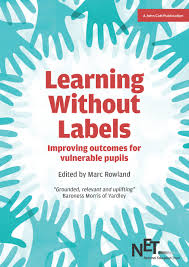Inspiration SEND Network Book Blog #1: a synopsis of the importance of Learning Without Labels
Back
Inspiration SEND Network is a network for SENCOs, aspiring SENCOs, senior leaders and governors that aims to develop leadership and knowledge of the evolving SEND landscape in order to improve outcomes for children and young people with SEND. Inspiration SEND Network was founded in February 2021 with the support of Teach First. It has 90 members from across the country and continues to grow. Alongside a fortnightly bulletin, the network runs half-termly, free-to-attend, online events on a variety of themes and most recently has launched 'Books for Blogs'. Our members have chosen a variety of books on the theme of Inclusion and SEND and have written about them here as a means of furthering their own learning and sharing it on. To join Inspiration SEND Network, sign up here or contact us at
sendnetwork@inspirationtrust.org.
Learning Without Labels: improving outcomes for vulnerable pupils -
Marc Rowland (ed.)
What a brilliant, uplifting and very readable book this is.
A somewhat unlikely opening sentence, given the grim reality of outcomes for vulnerable pupils: David Bartram tells us, for instance, that only 1 in 10 children with a learning disability can be expected to enter employment. However, in the first half of the book, a series of 12 short essays (500-600 words) from a range of contributors take a variety of ‘labels’ that teachers and leaders will be familiar with and both invite and challenge the reader to focus not on the labels themselves (widely agreed to be of limited use) but on the needs of the individual pupil.

Marc Rowland summarises 6 key features of the most effective schools, vis-à-vis vulnerable pupils, in his introduction: strong leadership, culture & values; high expectations; understanding of barriers to learning; targeted strategies; a reflective, evaluative culture; shared accountability for all pupils. Experienced leaders will recognise these features as characteristics which they continually strive for in their own schools. And yet. Jarlath O’Brien dares us to “be brutally honest” about how genuinely ambitious we are for vulnerable pupils, a sentiment echoed by Kate Masters: “the only ceiling all children have is the one placed upon them”, ceilings which labels like “low ability” and “SEN” have the potential to create and sustain to the detriment of outcomes for our most vulnerable pupils. If that makes for uncomfortable reading, it is balanced by a resounding sense that schools can have a positive impact; indeed high quality teaching, a personalised approach, parental and community engagement are all within a school’s gift. Martina Lecky makes the point that we need to see barriers as an opportunity for school leaders and staff to make a difference, rather than as obstacles to justify underachievement.
I particularly liked this book because it didn’t stop at reiterating the moral imperative inherent in its title. The second half of the book is dedicated to solutions and provides 14 short chapters on approaches which have been tried and tested in the contributors’ settings. From creating a language-rich experience in EYFS to address a language gap, to supporting adoptive families, to practical ways of encouraging white working class pupils to apply to university, to really practical strategies for supporting high mobility families, it’s a go-to for leaders looking for tried and tested solutions to an identified need. TA deployment is an area of focus for many leaders, including within our Trust, as we look to maximise the effectiveness of their practice. Scott Palmer’s scoring system for analysing the work of TAs in lessons in more detail is a really useful tool, the outcomes of which provide a starting point for implementing models of more effective classroom interaction. He describes a series of whole-day observations, where a score was assigned every 15 minutes according to the TA activity: 1 = passive; 2 = reacting to teacher request; 3 = independently following a previously agreed plan; 4 = taking the initiative to suggest next steps for the pupil to the teacher. Activities assigned scores of 3 or 4 would constitute more effective use of the TA. Palmer goes on to describe how, despite a predominance of scores in the 3 and 4 groups, they felt that 20% of 1 scores was too much. This is what is meant by being ambitious for all pupils and staff and having high expectations. Palmer’s school refined the in-class role of the TA to one he describes as being “more like co-teachers”: TAs have specific pupils to support, carrying out activities assigned by the class teacher, and complete a weekly log to report how they have made an impact on the pupils’ learning; in addition, TAs stand at the front of the room alongside the teacher to support with behaviour management, when the teacher is delivering the learning. Implementing a change of this kind is not without its challenges, as Palmer readily acknowledges and it is refreshing that he describes the process of leading the change in addition to the initiative itself. An annual review of TA deployment is part of ensuring that your provision meets the needs of the pupils and what I have learned here is an empirical way of approaching the effectiveness of in-class support that I can share with my teams and support them to implement so that they can ensure that TA practice and impact is maximised.
Harmer Parr’s afterword contained a couple of phrases which resonated with me: he states that “we talk about [early intervention] more than we practise it”. We need to ensure that we do take action, recognising that “vulnerability comes in many forms and responses to it require imagination and determination”. Simply doing the same things year on year will not yield different and better outcomes. Reading this book, either in its entirety or in part, will not only leave you feeling uplifted and galvanised into action but also give you practical strategies to implement in your setting for the benefit of those who need them most.
Catherine Berwick,
Trust Lead for SEND, Inspiration Trust
